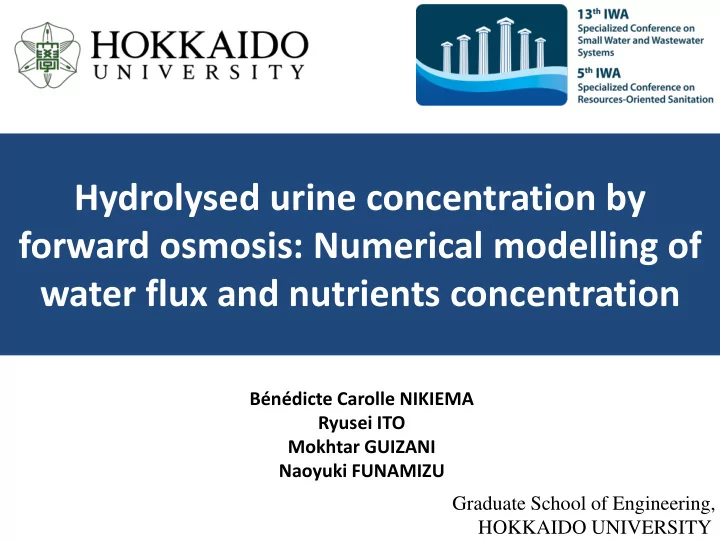

Hydrolysed urine concentration by forward osmosis: Numerical modelling of water flux and nutrients concentration Bénédicte Carolle NIKIEMA Ryusei ITO Mokhtar GUIZANI Naoyuki FUNAMIZU Graduate School of Engineering, HOKKAIDO UNIVERSITY
CRISIS OF CHEMICAL FERTILIZER DEMAND The global nitrogen, phosphorous and potassium (NPK) fertilizer demand is increasing and is affected by the population growth (FAO, 2015) Chemical fertilizer production problem Phosphorous is a limited ressource Nitrogen price is linked to the fluctuating price of energy Sustainable alternatives for nutrients management are needed 2
URINE AS AN ALTERNATIVE TO CHEMICAL FERTILIZER Nutrients generation in wastewater Urine fraction represents 80% of N, 55% of P and 60% of K [1] Urine reuse (system configuration) Household level Urine transportation Farmland (rural area) (urban or peri-urban area) 80% volume reduction Stored required for efficiency Water Urine Urine diverting systems 3 [1]Kirshman and Petterson, 1995
FORWARD OSMOSIS (FO) FOR URINE CONCENTRATION Water flux ( Jw = K. ∆π ) Membrane FO models developed focus • Reverse draw solution diffusion Osmotic • Concentration polarizations pressure • (∆π ) Single solute in the system Additional considerations required • Feed solutes diffusion • Multiple solute diffusion in the system Hydrolyzed urine Sodium chloride ( Na, Cl, K , PO4, ( Na, CL) NH3, IC, TOC) A new model is required 4 for estimation of water flux in hydrolyzed urine
RESEARCH OBJECTIVE To develop a numerical FO model for hydrolyzed urine concentration To prepare a new numerical model considering the bidirectional diffusion of multiple components through the FO membrane To estimate the membrane permeability and solutes (Na, K, Cl, PO 4 , NH 3 ) diffusivities through a FO membrane by fitting To simulate hydrolyzed urine concentration by FO 5
FO EXPERIMENTAL SET UP Water flux Diffusion FS and DS volumes : 500 ml Flow rate FS and DS : 14L/h Sampling of FS and DS every hour 6
MODEL EQUATIONS Using the mass transport across an asymmetric FO membrane Draw solution Feed solution SL AL The equations were solved with Crank Nicholson scheme 7 The solutions were obtained by Newton Raphson method
EXPERIMENTAL PROCEDURE Run1: Water permeability estimation Feed solution Draw solution Deionized NaCl water ( 0.02, 0.05, 0.1, 0.2, 0.5 mol/L ) 3,5 y = 0,3279x water flux(L/m2.h)) 3 R² = 0,9919 2,5 2 1,5 1 0,5 0 0 5 10 Δπ (10 5 Pa) 8
EXPERIMENTAL PROCEDURE Run2: Fitting for diffusivities estimation Feed solution Draw solutions NaCl , 0.5 M NH 4 Cl (pH 9.4) , 1.4 M Deionized water Na 2 HPO 4 , 0.5M KCl , 0.5M Run 3 : Simulation of Hydrolyzed urine concentration Feed solution Draw solutions Hydrolysed urine NaCl (4M) 9
ESTIMATION OF THE DIFFUSIVITIES BY FITTING SL : 2.5 x 10 -10 m 2 /s Sodium Chloride (Na,Cl) Al :2.75 x 10 -12 m 2 /s FS Water flux DS 6 0,6 0,004 Exp Na Concentration (mol/L) Concentration (mol/L) Water flux (l/m2.h) 4 0,4 Sim 0,002 Cl 2 0,2 Jw_Exp Jw_Sim 0 0,0 0,000 0 1 2 3 0 1 2 3 0 1 2 3 Time (h) Time (h) Time (h) SL : 5.5 x 10 -10 m 2 /s Potassium (K) AL: 2.85 x 10 -12 m 2 /s FS Water flux DS 0,6 8 0,004 Exp Concentration (mol/L) K Water flux (L/m2.H) Concentration (mol/L) 6 0,003 0,4 Sim 4 0,002 Cl 0,2 2 Jw_Exp 0,001 Jw_Sim 0 0,0 0,000 0 1 2 3 0 1 2 3 0 1 2 3 Time(h) 10 Time (h) Time (h)
ESTIMATION OF THE DIFFUSIVITIES BY FITTING SL : 1.5 x 10 -10 m 2 /s Phosphate (PO 4 ) AL: 1.85 x 10 -12 m 2 /s Water flux DS FS 0,6 6 0,004 Sim Na Concentration (mol/L) Concentration (mol/L) Water flux(l/m2.H) 0,003 4 0,4 Exp 0,002 PO4 2 0,2 0,001 0 0,0 0,000 0 1 2 3 0 1 2 3 0 1 2 3 Time (h) Time (h) Time (h) SL: 1.5 x 10 -9 m 2 /s Ammonia (NH 3 ) AL: 5.75 x 10 -12 m 2 /s DS FS Water flux 12 0,04 Exp 1,6 Concentration (mol/L) Concentration (mol/L) Water flux (L/m2.H) NH 3 0,03 1,2 8 0,02 0,8 Sim 4 0,4 0,01 Cl 0,0 0,00 0 0 1 2 3 4 5 0 1 2 3 4 5 0 1 2 3 4 5 Time (h) Time (h) 11 Time (h)
HYDROLYZED URINE SIMULATION 20 6 Water flux Na Concentration Na (mol/L) Water flux (L/m2.H) Sim 4 10 DS 2 Exp FS 0 0 0 2 4 6 8 0 2 4 6 8 Time(h) Time (h) 6 Cl NH3 Concentration Cl (mol/L) 4 DS 2 DS FS 0 0 2 4 6 8 Time (h) The simulation results agreed to the water flux and NaCl concentrations except NH 3 concentration which was estimated above. 12
SUMMARY A new numerical model was developed The permeability was experimentally estimated The diffusivities of solutes were estimated but NH 3 concentration had a deviation Good simulation of water flux and draw solute concentration were obtained however feed solute simulation should be improved. Further considerations should be included in the model such as NH 3 and NH 4 species concentrations variation in the feed and 13 draw solution.
14
Supporting information Composition of human synthetic urine 15
Supporting information Membrane Membran Time Number of AL thickness e division step division (m) ∆x (m) ∆t(s) n Al ( 20 x 10 -6 ) 4 X 10 -6 0.1 20 Sl ( 60 x 10 -6 ) SL SEM picture of the cross section of a CTA membrane 16
Recommend
More recommend